tryg
New Member
We talk all the time about swapping out this unit or that sensor; what are they and what do they do? Here is a short list of some common engine sensors, the list is not exhaustive - there are many more on your car (depending on your car!)
MAP SENSOR:
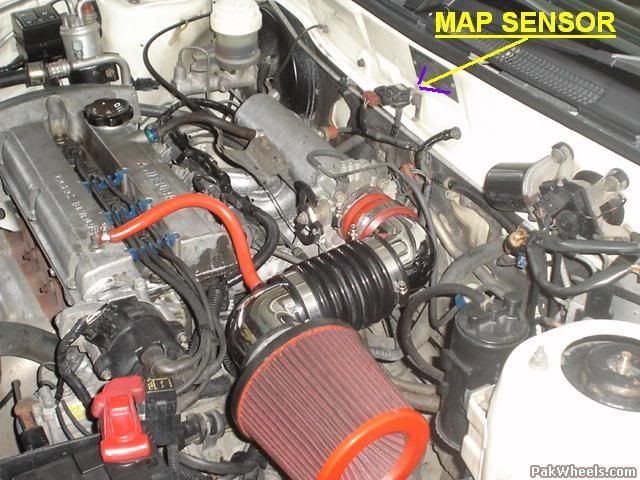
This stands for Manifold Absolute Pressure Sensor. It's nothing but an electronic vacuum gage. As the manifold vacuum changes, the MAP sensor supplies a variable voltage to the computer.
FAILURE SYMPTOMS: Poor running, stalling, light on dash NOTE: A MAP sensor can be inaccurate, sending an incorrect voltage to the computer. If this voltage is still within the range of voltage the computer expects, a light or trouble code for the MAP sensor may not be set. Fords are particularly susceptable to this. problem. Thus, if the MAP is old, it might be a good maintenance item.
TEMPERATURE SENSOR:
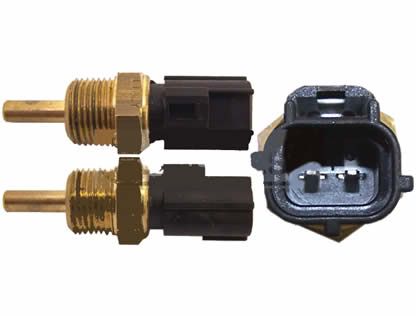
Often a car will have several of these. All of them have a coolant/engine block temperature sensor. Some also have a manifold temp sensor and an intake air temperature sensor.
FAILURE SYMPTOMS: Rich or lean mixture, black smoke (rich), light on dash
THROTTLE POSITION SENSOR:
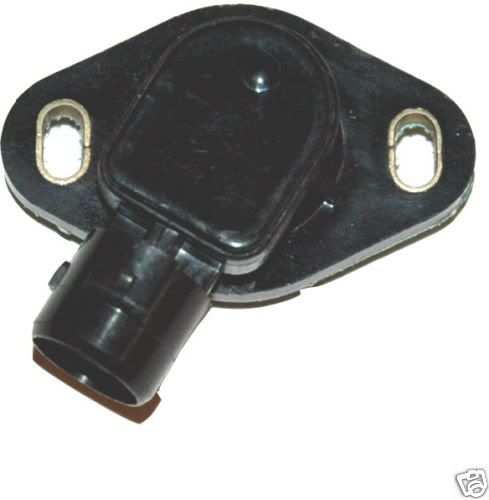
This lets the computer know how far you press the accelerator pedal down. It often has a wide open throttle and a closed throttle switch either as part of it or as separate components. In older vehicles, this was a continuous printed variable resistor, they failed because of wear marks on the printed surface. Later cars incorporate these directly into the fly-by-wire pedal assemblies.
FAILURE SYMPTOMS: Hesitation on quick acceleration (passing, "floorboarding it") , sometimes bad idle. May not illuminate light or set codes.
MASS AIRFLOW SENSOR:

This actually measures how much air enters the engine and adjusts the fuel/air mixture accordingly.
FAILURE SYMPTOMS: Poor running, stalling: all conditions. May not illuminate light or set codes.
OXYGEN SENSOR:
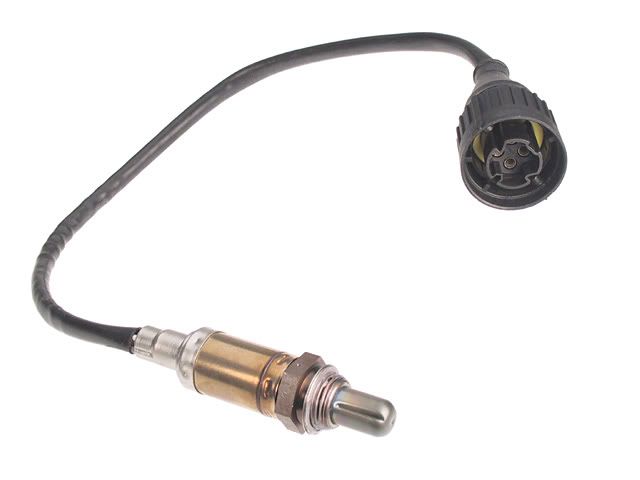
This measures the exhaust oxygen content. The computer fine tunes the mixture using data from this sensor.
FAILURE SYMPTOMS: Poor fuel economy, driveability, light on dash.
THE HEGO SENSOR
(Heated Oxygen Sensor): First seen on Fords (I add this because I've had trouble on my FORDs!), this is just an Oxygen sensor, except it's HEATED! Heated Exhaust Gas Oxygen sensor. It is electrically heated so it works immediately on engine startup: the other type must be heated by the exhaust before it starts to work. Computers using these place a lot more emphasis on the data from the Oxygen sensor, and use this data sooner while the engine is still cold.
CRANKSHAFT/DISTRIBUTOR/CAMSHAFT POSITION SENSOR: (depending on your car)
Used on all engines with computerized timing advance, this tells the computer which cylinder should be firing. Some engines use a sensor on the front pulley of the engine (Harmonic balancer or vibration dampener), another sensor in the engine block on a special toothed wheel on the crankshaft inside the engine block, and a third sensor on the camshaft gear. Earlier systems have a pickup inside the distributor as the only input as to crank position.
FAILURE SYMPTOMS: No start, hesitation, misfire
BAROMETRIC PRESSURE SENSOR:
This adjusts the mixture according to altitude: the same settings won't work both in Brisbane and Toowoomba! FAILURE SYMPTOMS: Poor fuel economy, light on dash In addition, the computer often monitors things like vehicle speed, brake pedal on or off, power steering pressure, A/C on or off, and transmission shifter position (tells it what gear you're in).
FAILURE SYMPTOMS: Poor fuel economy, light on dash, stalling while parking or at traffic lights All vehicles do not have all of these sensors.
If you have turbo, you will have a pressure sensor for that too!
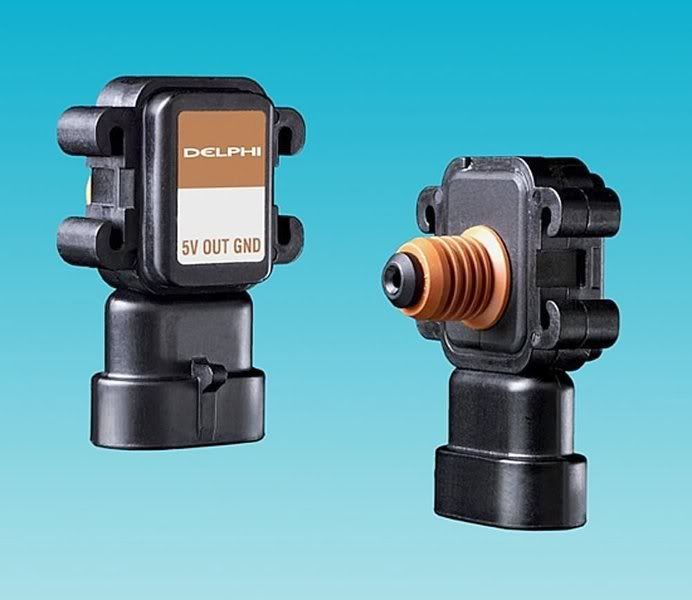
THE CRITICAL SENSORS:
For most cars the "essential" or "major" sensors are: MAP sensor, Mass Airflow Sensor (if so equipped), Engine Block Temperature Sensor, and the Crankshaft/Distributor Position Sensor. These sensors can make an engine barely run or not run at all. The other sensors make very fine adjustments to the fuel/air mix and timing and will not cause a gross poor running condition.
This is important, because often a "major" sensor will cause a "minor" sensor to read out of specs. If the car barely runs, or doesn't run at all, suspect one of these "major" sensors (and other non-computer stuff, like wiring, coil, or fuel supply) before trying to trace down a code generated by a "minor" sensor.
FOR EXAMPLE : BE CAREFUL WITH COMPUTER CODES: THEY CAN MISLEAD YOU !
Your car smokes black, smells like gas, and barely runs. The computer gives a "rich oxygen sensor" trouble code.
The Oxygen sensor is replaced. ------- The car still smokes black, still has a "rich oxygen sensor" trouble code. The codes said the Oxygen Sensor reads rich.
This just confirms what any good mechanic could tell by smelling the exhaust: it's running rich!! The car really needs a temperature, MAP, or Mass Airflow sensor , or possibly a carburetor rebuild or fuel injection service.
Cars with bad Injectors can smoke, giving rich Oxy sensor readings at idle, but setting no other trouble codes.
LIMP HOME MODE:
When the computer decides enough sensor inputs are out of proper range, it will go to a "limp home mode". This mode has effects from almost unnoticeable to fairly radical, depending on what car you have. The mild case is a CEL (dash light) and bad fuel economy.
Some cars (with computer shifted transmissions) will stay in second gear when in limp home mode! In limp home mode, the computer uses assumed values to control fuel and spark rather than measured (and constantly adjusted) values. This results in poor fuel economy and bad driveability.
MAP SENSOR:

This stands for Manifold Absolute Pressure Sensor. It's nothing but an electronic vacuum gage. As the manifold vacuum changes, the MAP sensor supplies a variable voltage to the computer.
FAILURE SYMPTOMS: Poor running, stalling, light on dash NOTE: A MAP sensor can be inaccurate, sending an incorrect voltage to the computer. If this voltage is still within the range of voltage the computer expects, a light or trouble code for the MAP sensor may not be set. Fords are particularly susceptable to this. problem. Thus, if the MAP is old, it might be a good maintenance item.
TEMPERATURE SENSOR:

Often a car will have several of these. All of them have a coolant/engine block temperature sensor. Some also have a manifold temp sensor and an intake air temperature sensor.
FAILURE SYMPTOMS: Rich or lean mixture, black smoke (rich), light on dash
THROTTLE POSITION SENSOR:

This lets the computer know how far you press the accelerator pedal down. It often has a wide open throttle and a closed throttle switch either as part of it or as separate components. In older vehicles, this was a continuous printed variable resistor, they failed because of wear marks on the printed surface. Later cars incorporate these directly into the fly-by-wire pedal assemblies.
FAILURE SYMPTOMS: Hesitation on quick acceleration (passing, "floorboarding it") , sometimes bad idle. May not illuminate light or set codes.
MASS AIRFLOW SENSOR:

This actually measures how much air enters the engine and adjusts the fuel/air mixture accordingly.
FAILURE SYMPTOMS: Poor running, stalling: all conditions. May not illuminate light or set codes.
OXYGEN SENSOR:

This measures the exhaust oxygen content. The computer fine tunes the mixture using data from this sensor.
FAILURE SYMPTOMS: Poor fuel economy, driveability, light on dash.
THE HEGO SENSOR
(Heated Oxygen Sensor): First seen on Fords (I add this because I've had trouble on my FORDs!), this is just an Oxygen sensor, except it's HEATED! Heated Exhaust Gas Oxygen sensor. It is electrically heated so it works immediately on engine startup: the other type must be heated by the exhaust before it starts to work. Computers using these place a lot more emphasis on the data from the Oxygen sensor, and use this data sooner while the engine is still cold.
CRANKSHAFT/DISTRIBUTOR/CAMSHAFT POSITION SENSOR: (depending on your car)
Used on all engines with computerized timing advance, this tells the computer which cylinder should be firing. Some engines use a sensor on the front pulley of the engine (Harmonic balancer or vibration dampener), another sensor in the engine block on a special toothed wheel on the crankshaft inside the engine block, and a third sensor on the camshaft gear. Earlier systems have a pickup inside the distributor as the only input as to crank position.
FAILURE SYMPTOMS: No start, hesitation, misfire
BAROMETRIC PRESSURE SENSOR:
This adjusts the mixture according to altitude: the same settings won't work both in Brisbane and Toowoomba! FAILURE SYMPTOMS: Poor fuel economy, light on dash In addition, the computer often monitors things like vehicle speed, brake pedal on or off, power steering pressure, A/C on or off, and transmission shifter position (tells it what gear you're in).
FAILURE SYMPTOMS: Poor fuel economy, light on dash, stalling while parking or at traffic lights All vehicles do not have all of these sensors.
If you have turbo, you will have a pressure sensor for that too!

THE CRITICAL SENSORS:
For most cars the "essential" or "major" sensors are: MAP sensor, Mass Airflow Sensor (if so equipped), Engine Block Temperature Sensor, and the Crankshaft/Distributor Position Sensor. These sensors can make an engine barely run or not run at all. The other sensors make very fine adjustments to the fuel/air mix and timing and will not cause a gross poor running condition.
This is important, because often a "major" sensor will cause a "minor" sensor to read out of specs. If the car barely runs, or doesn't run at all, suspect one of these "major" sensors (and other non-computer stuff, like wiring, coil, or fuel supply) before trying to trace down a code generated by a "minor" sensor.
FOR EXAMPLE : BE CAREFUL WITH COMPUTER CODES: THEY CAN MISLEAD YOU !
Your car smokes black, smells like gas, and barely runs. The computer gives a "rich oxygen sensor" trouble code.
The Oxygen sensor is replaced. ------- The car still smokes black, still has a "rich oxygen sensor" trouble code. The codes said the Oxygen Sensor reads rich.
This just confirms what any good mechanic could tell by smelling the exhaust: it's running rich!! The car really needs a temperature, MAP, or Mass Airflow sensor , or possibly a carburetor rebuild or fuel injection service.
Cars with bad Injectors can smoke, giving rich Oxy sensor readings at idle, but setting no other trouble codes.
LIMP HOME MODE:
When the computer decides enough sensor inputs are out of proper range, it will go to a "limp home mode". This mode has effects from almost unnoticeable to fairly radical, depending on what car you have. The mild case is a CEL (dash light) and bad fuel economy.
Some cars (with computer shifted transmissions) will stay in second gear when in limp home mode! In limp home mode, the computer uses assumed values to control fuel and spark rather than measured (and constantly adjusted) values. This results in poor fuel economy and bad driveability.
